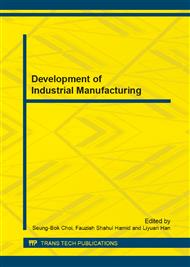[1]
T. Kuwahara. Eddy Current Braking System. US5143183, 1992-09-01.
Google Scholar
[2]
Kap Jin Lee, KyiHwan Park. Torque control of an eddy current brake system[J]. Proc Ksme, 1997, A: 434-439.
Google Scholar
[3]
BAO Zheng-xiang, ZHAO Zheng-ming, YU Ye-lin. The Control System of Electron-magnetic Retarders Based on PWM[J]. Journal of Huai Yin Teachers College(Natural Science Edition). 2003. 2(3). 196-(1999).
Google Scholar
[4]
Yi Lu, Tie-Qi Chen, Brennan Hamilton. A Fuzzy System for Automotive Fault Diagnosis [J] . SAE9819074.
Google Scholar
[5]
ZHU Wei-xing,TANG Jun, He Ren. Application of on-line rule of self-regulation steeping fuzzy control to eddy current retarder. Journal of Jiang su University(Natural Science Edition) . 2006. 27(2). 126-129.
Google Scholar
[6]
He Shi-Zhong, Tan Shao-hua, Hang Chang-Chie. Control of dynamical processes using an on-line rule-adaptive fuzzy control system[J]. Fuzzy Sets and Systems, 1993, 54: 11-22.
DOI: 10.1016/0165-0114(93)90356-m
Google Scholar
[7]
ZHU Wei-xing, Mao Han-ping, LI Ping-ping et. A fuzzy controller based on genetic optimization and its application to a distributed control system of greenhouse[J]. Transactions of the Chinese Society for Agricultural Machinery, 2002, 33(3):76-79.
Google Scholar
[8]
Wu Yihu, Wang Cui, Zhou Li. A simulation of vehicle lateral stability based on fuzzy PID control[C]. 2009 International Conference on Measuring Technology and Mechatronics Autormation, 2009: 194-199.
DOI: 10.1109/icmtma.2009.471
Google Scholar
[9]
SUN Hua, ZHANG Tao . Fuzzy PID Control and Simulation Experiment on Permanent Magnet Linear Synchronous Motor[J]. Machine Tool & Hydraulics. 2011. 39(5). 108-110.
DOI: 10.4028/www.scientific.net/amr.383-390.2608
Google Scholar
[10]
Matthew Burke and Robert Oaten. Midi-Bus Infinitely Variable Transmission Retarder Deletion Study[J]. SAE Pape N0: 2005-01-3546.
DOI: 10.4271/2005-01-3546
Google Scholar
[11]
Scott Kimbrough. Optimal Control of Electromagnetic Brake Retarde[J]. SAE Paper No: 942325.
Google Scholar
[12]
J. Bigeon. Finite Element analysis of an Electromagnetic Brake[J]. IEEE,Trans. Of Magnetic,Vol. 19, No. 6, Nov, 1983: 26322634.
Google Scholar


